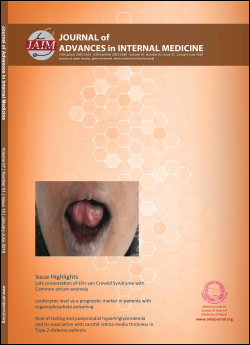Role of fasting and postprandial hypertriglyceridemia and its association with carotid intima media thickness in Type II diabetes patients
DOI:
https://doi.org/10.3126/jaim.v7i1.19578Keywords:
Diabetes Mellitus, Postprandial triglycerides, Carotid intima media thickness, AtherosclerosisAbstract
Background and aim: Type 2 diabetes mellitus is associated with the development of premature arteriosclerosis and a higher cardiovascular morbidity and mortality. Diabetic dyslipidaemia is believed to play an important role in the pathogenesis of accelerated atherosclerosis in this condition. B-mode ultrasound enables non-invasive, direct visualization of the arterial wall. The aim of this study was to correlate intima media thickness of the carotid artery (CIMT) quantification as a reliable marker of atherosclerotic burden in diabetes patients.
Method: It was a Cross Sectional Study done on 50 patients in the age group of 30-70 years with type II Diabetes Mellitus of more than 5 years duration without hypertension. Carotid Intima Media Thickness (CIMT) was measured using an echotomographic system with a 7.5-MHz linear transducer probe. With the carotid bulb and the longitudinal projection of the common carotid artery 2cmx from carotid bulb, the site of the greatest thickness including a plaque lesion was sought along both near and far walls bilaterally.
Results: The mean CIMT of subjects with fasting triglyceride level less than 150 mg/ dL was 13.2±0.48 mm with a range of 0.6-2.4 mm. Similarly the level between 150- 200 mg/dL was 1.89±0.54 mm with a range of 1.3-2.6 mm and level more than 200 mg/dL was 2.00±0.63 mm with a range of 0.8-2.6 mm. From the present study, it is clearly evident that age, duration of disease, fasting triglycerides and postprandial triglycerides have a significant impact on the CIMT, whereas other variables are having any significant impact on CIMT.
Conclusion: The present study concludes both fasting and postprandial triglyceride levels correlate significantly with carotid intima media thickness. But, the correlation of postprandial triglyceride levels with carotid intima media thickness is better than that of fasting triglyceride levels with carotid intima media thickness, the postprandial hypertriglyceridemia despite normal fasting triglyceride level can be considered as an independent risk factor for atherosclerosis in type 2 diabetes mellitus.
Downloads
Downloads
Published
How to Cite
Issue
Section
License
This license enables reusers to distribute, remix, adapt, and build upon the material in any medium or format, so long as attribution is given to the creator.




